On a trip to Italy, one of the most rewarding and relaxing things to do is to visit one of the many beautiful gardens in Italy. From botanical collections to stunning gardens that make the most of their dramatic setting, these Italian gardens are sure to refresh and inspire you. Which garden would you choose to visit?
Gardens in Northern Italy
Villa del Balbianello, Lake Como
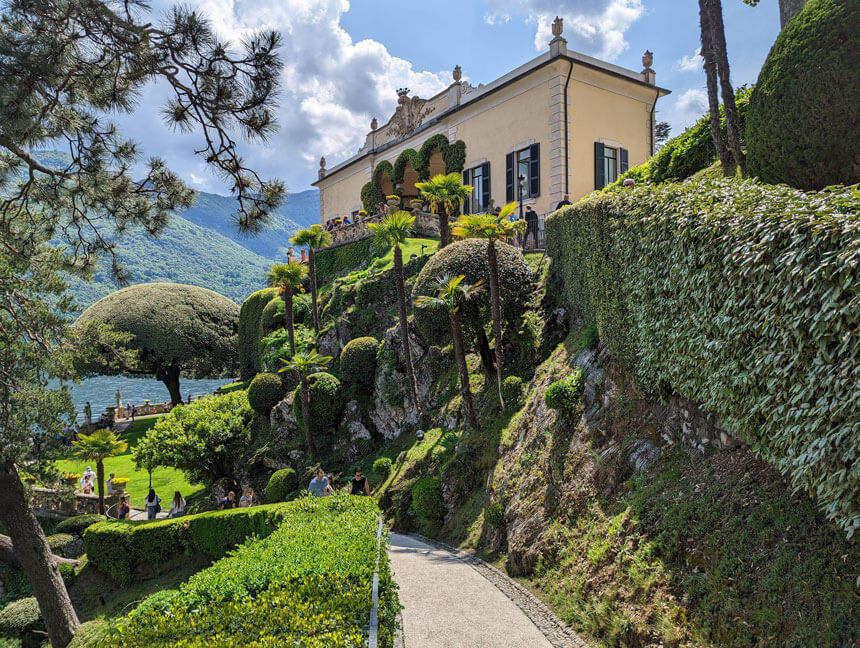
Villa del Balbianello, on the western shore of Lake Como, is one of the most romantic and idyllic gardens in Italy, and a favourite of celebrity gardener Monty Don. The villa and its lovely gardens are set on a wooded peninsula, giving the gardens beautiful views over the lake from three sides.
The villa was built in the late 1700s and includes some traces of an earlier 13th-century Franciscan monastery. The villa changed hands several times over the next 200 years until a famous Italian explorer, Guido Monzino, bought it in the 1970s. After his death in 1988, the house and its gardens were donated to the Italian version of the National Trust.
The most notable feature of the gardens at Villa del Balbianello is its carefully-pruned holm oak trees. Each one forms a perfect dome, contrasting beautifully with the mountains around the lake and the tall plane trees.
Read more: Tips for visiting Villa del Balbianello, Lake Como
Giardino Giusti, Verona
By Ivan from Mindthetravel.com
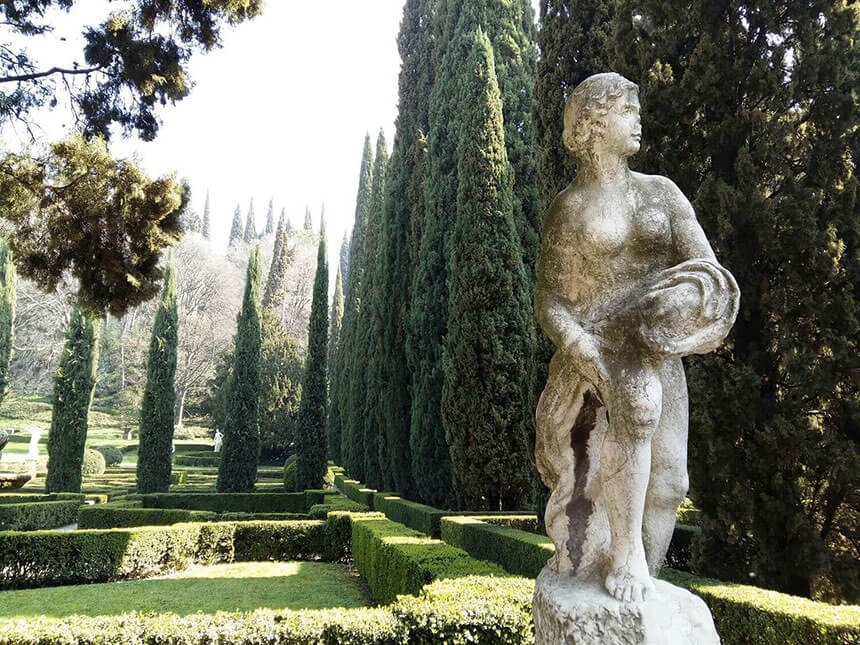
A dazzling Italian garden that oozes beauty and romance, Giardino Guisti is one of the most attention-worthy gardens in Verona. This is arguably the finest example of an Italian Renaissance villa garden in Italy, and attracted the attention of Goethe and Mozart.
While the well-maintained garden was founded in the 1400s, the layout was commissioned in 1570 by Agostino Giusti. The acoustic grottoes, maze-like hedges, tall cypress trees, statues scattered around, and terrace gardens, comprise a unique feature of the garden. Giardino Guisti will give everyone who visits it the chance to immerse in the atmosphere of the 16th century. Don’t miss out on strolling the impressive walkways and visiting a villa situated in the lower area.
As you explore the garden you’ll notice the stark contrast between the lower area of perfectly manicured box hedges and the upper area of natural wilderness. The final climb takes you to the belvedere revealing one of the finest views across Verona over the villa’s rooftop.
Botanical Gardens, Padua
By Molly from Luggage and Life
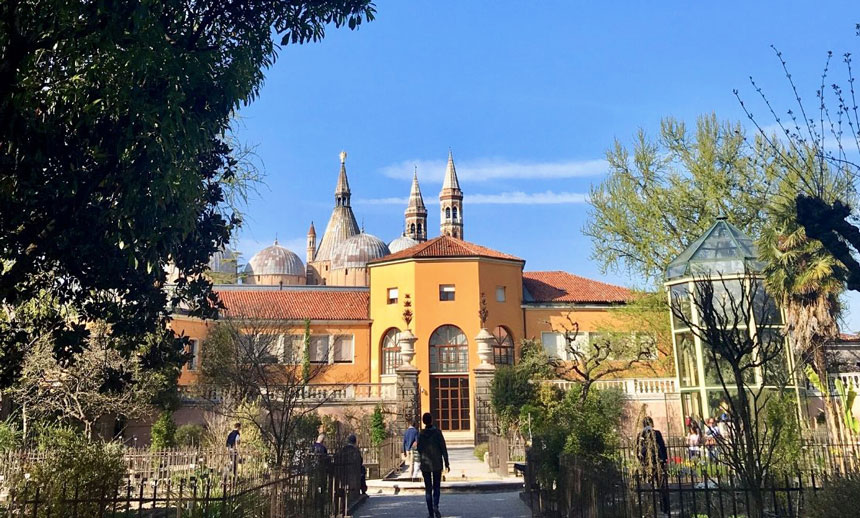
The Botanical Garden of the University of Padua is the oldest of its kind in the world. Created in 1545, the original aim of the garden was to educate medical students on the medicinal properties of plants, and to assist them in learning to recognise which plants were helpful to human health, and which were harmful.
Owing to Padua’s proximity to Venice, the garden expanded thanks to Venetian traders who brought back plants from their travels. Today, it is estimated that the garden is home to some 7,000 plants and about 3,500 species. Its impressive collection spans outdoor plots and a massive conservatory, which is divided into five sections:
Mediterranean maquis (thick, scrubby vegetation characteristic of the Mediterranean coast), Alpine flora, fresh-water plants that are fed by a thermal spring, succulents, and a tropical area for orchids. Within these environments, visitors will still find medicinal plants, but there are also poisonous and carnivorous ones, plants from the nearby Euganei Hills and others from faraway places.
The garden’s modern mission is to conserve biodiversity. Every year, the Index Seminum is published, which is a list of seeds and spores that the garden exchanges with other botanical gardens, universities and research centres to promote this mission beyond its walls.
In addition to being home to the first academic botanical garden in the world, Padua also has the largest piazza in Italy, an 800-year-old market, and the first kiss depicted in Western art!
Trauttmansdorff Gardens, Merano
By Dave Chant, www.davechant.com
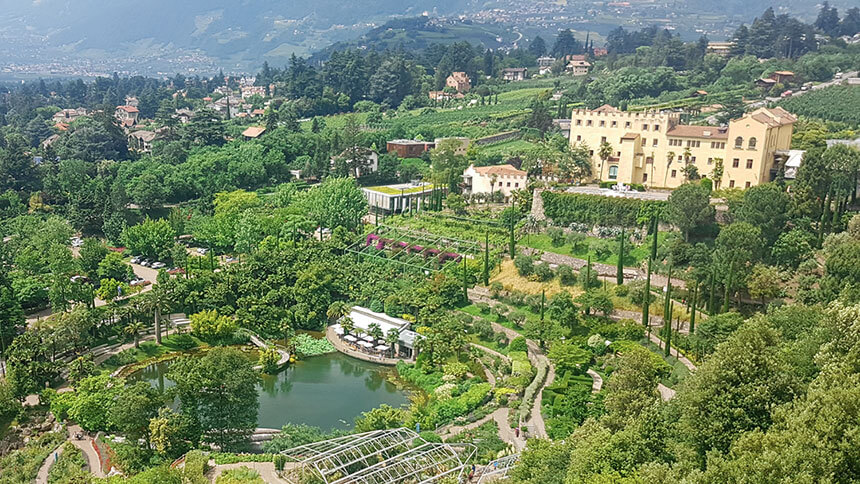
The Trauttmansdorff Castle Gardens, as they are officially known, are located in the small town of Merano in Northern Italy. Being the South Tyrol and close to Austria, this part of Italy is quite Germanic and hence the name. Merano itself is a beautifully twee town to visit, not very well known except for its spas, but with a delightful narrow alleyed town centre.
The gardens themselves are set in a 12 hectare land next to the castle (which now houses a museum of tourism). They were laid out in 1850 by the Count during the restoration of the castle, but restored shortly before 2001 when it was opened to the public. As such, it’s a new garden, but delightful to wander.
It includes different areas, at the focal point is the Water Lily pond where concerts are occasionally held. From top to bottom there is a 100-metre height difference, so the Matteo Thun viewing platform offers stunning views out across the valley to the mountains beyond.
There’s also the Sun Gardens with Mediterranean plants, and the Forests of the World bringing both North and South American Influences, as well as Japanese.
It’s open from April to mid-November, each day, and a half day is a great amount of time to spend relaxing in the gardens. Couple it with a morning or evening in Merano centre, and you’ve got the making of a fabulous day out in one of the prettiest gardens in Italy.
Villa and Gardens Garzoni in Collodi, Tuscany
By Gabrijela Zec from Under Flowery Sky
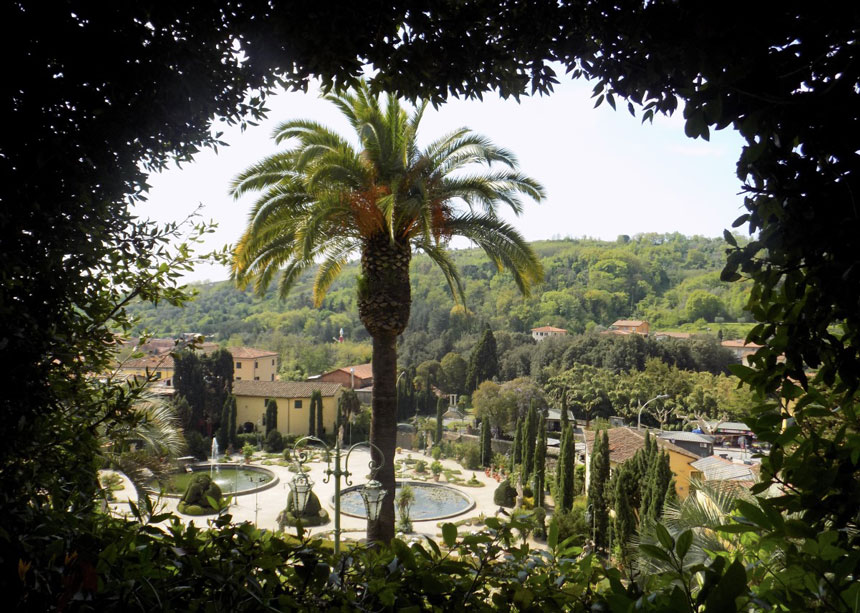
The picturesque village of Collodi, the home of Pinocchio, also hosts the enchanting gardens at Villa Garzoni. It’s located only half an hour by bus from Lucca and was created in the 17th century by the Garzoni family as a refuge from the city in the tranquillity of nature.
Visitors to the gardens will discover elegant planting with artistic sculptures, but once it was an abandoned ancient castle. At the entrance, the water garden welcomes you with enchanting flower beds and sculptures. Up the flights of stairs, the visitor will be continually surprised with mythological statues, window views of the garden, a bamboo forest, peacocks and fountains.
So much beauty in one relatively small area is just outstanding, and it’s not surprising that the Villa Garzoni’s gardens were appreciated by famous visitors including Napoleon.
Isola Bella, Lake Maggiore
By Anda from Travel For A While
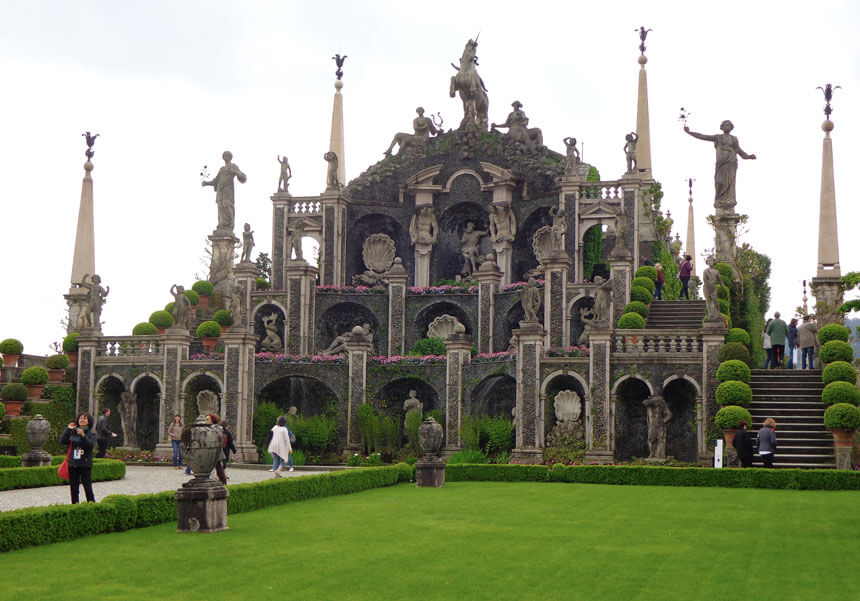
Isola Bella is one of the islands on Lake Maggiore that have been in the Borromean family for 500 years now. The small rocky island is almost entirely occupied by a palace and an incredible garden. Carlo III Borromeo started the transformation of the island in 1631, intending to make a villa and a garden for his wife, Isabella. Carlo Fontana, a famous architect from Rome was hired to complete the work.
Architects designed an extravagant Italian Baroque-style garden, bringing in soil to create ten artificial terraces for a pyramid shape. The central piece of the garden is Teatro Massimo, an eccentric three-story structure covered in black pebbles. The unicorn at the top is one of the symbols from the coat of arms of the Borromean family.
Getting back to the gardens, rhododendrons, camellias, roses, magnolias, hibiscus and oleanders adorn the terraces. The mild microclimate of the lake allows some trees to flourish here which are rare for this latitude. Camphor and citrus fruit trees grow in this amazing garden. On the perfect lawns, white peacocks walk imperially, scaring the visitors with the sharp sound they make.
The palace and the garden can be visited every day from the end of March to the end of October. You can get to Isola Bella on a short boat ride from Stresa village on the shore of Lake Maggiore.
Parco Giardino Sigurtà, Lake Garda
By Noel from Travel Photo Discovery
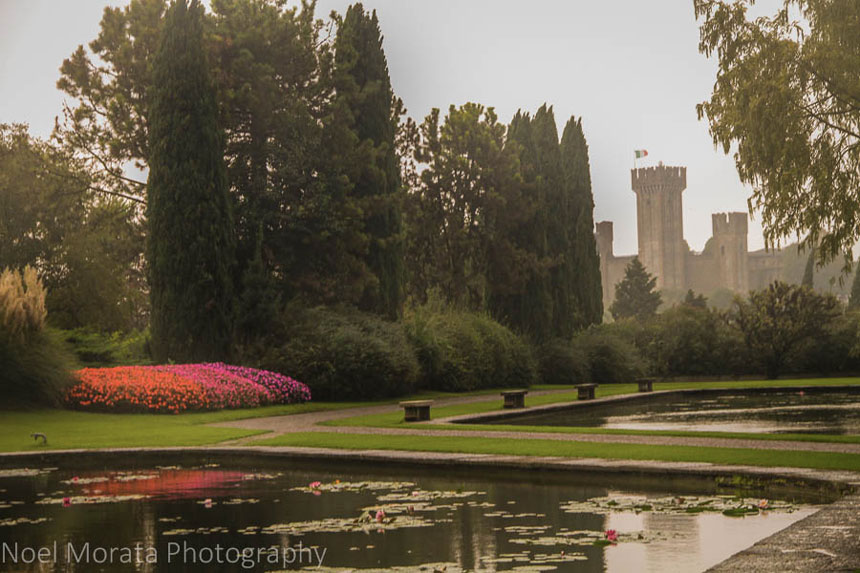
Of all the stunning gardens to visit in Italy, probably not so well known is Parco Giardino Sigurtà located in the Lake Garda region of Northern Italy. This beautiful botanical garden is quite special with an entire hillside dedicated to the stunning views and individual garden areas to explore. An easy thing to do is to take a train tour of the garden which winds through all the fantastic areas of the garden to explore and you’ll also get a chance to photograph some of the scenic views throughout the garden.
Towards the entrance of the garden you can do a self tour through some of the easy to get to parts with nice spring beds in a burst of colours. With over 600,000 square metres of forests and ancient woods, water gardens, formal beds and an amazing tulip display of over a million tulips during Tulipmania, you can enjoy an entire morning, if not day exploring the entire park. There’s even an educational farm and maze for kids to enjoy and learn about the animals in the park.
Established since 1617, this historic botanical garden is a real blend of old world and ancient trees, formal structure with Italian cypresses and an impressive hermitage. There’s a lot to see and do and photograph during all the seasonal changes and definitely worth the effort of visiting the garden.
Boboli Gardens, Florence
By Samantha from The Wandering Wanderluster
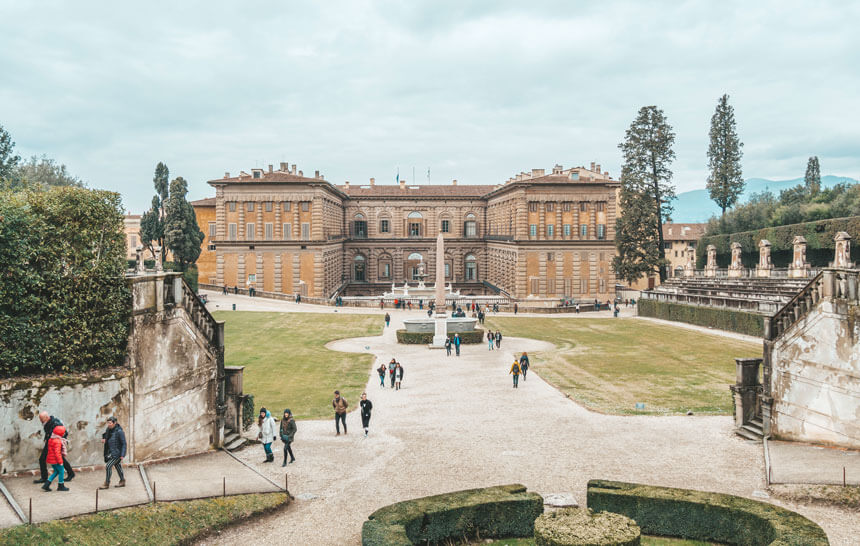
Located on the southern bank of Florence, in the area of Oltrarno lies the former palace of the Medici family, the Pitti Palace. Hidden behind the grand facade of the palace which holds multiple museums lies one of Florence’s most enchanting sights, the Boboli Gardens.
Dating back over 400 years, the Boboli Gardens are more than just a large park with pretty statues, it is an open-air museum and one of the city’s most important places of historical importance. The green oasis which was heavily inspired by many of the other famous European Royal Gardens like Versailles and Caserta existed long before the Medici family moved into the Pitti Palace in 1549. But it was the Medici and the Lorraine families who transformed the gardens into what we see today.
Over the course of 400 years, the gardens were enriched with statues, sculptures, ancient oak trees and beautiful fountains. Other highlights of the gardens include the Amphitheatre style garden located close to the entrance, Neptune’s fountain located at the top of the hill and the Grotta Grande which is decorated with stalactites and was once home to the artwork The Prisoners by Michelangelo which can now be found in the Accademia Gallery.
A €10 ticket gains you entrance into the famous gardens which sprawl over 11 acres and multiple levels and you can also buy a combo ticket if you wish to visit the interior or the Pitti Palace as well. You could easily spend half a day exploring and relaxing in the gardens. Two top tips would be to wear comfortable shoes because you will be walking on different terrains and climbing steps and to bring plenty of water if you visit during the summer months, you could even bring a picnic!
Giardino dell’iris, Florence
By Matt from It’s All In Italy!
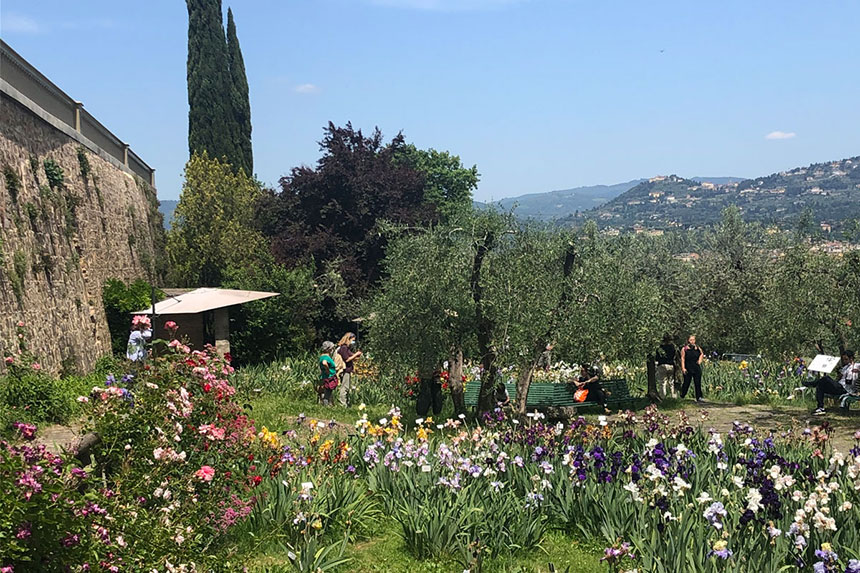
Giardino dell’iris is a beautiful garden located adjacent to Piazza Michelangelo in historical Florence, Italy.
It opened in 1954 with the goal to host an annual international competition for the best varieties of Iris worldwide.
Giardiono dell’iris was conceived by Flaminia Specht and Nita Stross Radicati, passionate hybridizers and members of the local Italian Society Amici dei Fiori (Italian Society of Friends of Flowers).
The Iris has special significance to the city of Florence, appearing on its flag since 1250. It’s often thought that a Lily is the symbol of Florence, but this is a mistake. It’s the Iris that features on the Florentine flag.
The Giardino dell’iris has its special time of the year during March to May when the Iris bloom, creating a magical kaleidoscope of colours and enriching all that visit the garden.
For the annual international Iris competition, the rhizomes of each Iris variety are sent to Florence by worldwide breeders between June to September and are cultivated in the Florence Iris Garden for 3 years before being judged by an International Jury.
Spanning 2.5 hectares amongst an olive grove, the well laid out and paved garden takes the visitor on a journey of sights and smells that allow a brief escape from the busy world.
The garden also offers stunning panoramic views over Florence thanks to its commanding hilltop position.
Be sure to add the unique Giardino dell’iris to your Florence itinerary to witness the beauty and fragility that is the Iris.
Gardens in and around Rome
Villa d’Este Gardens, Tivoli, near Rome
By Becki from Meet Me In Departures
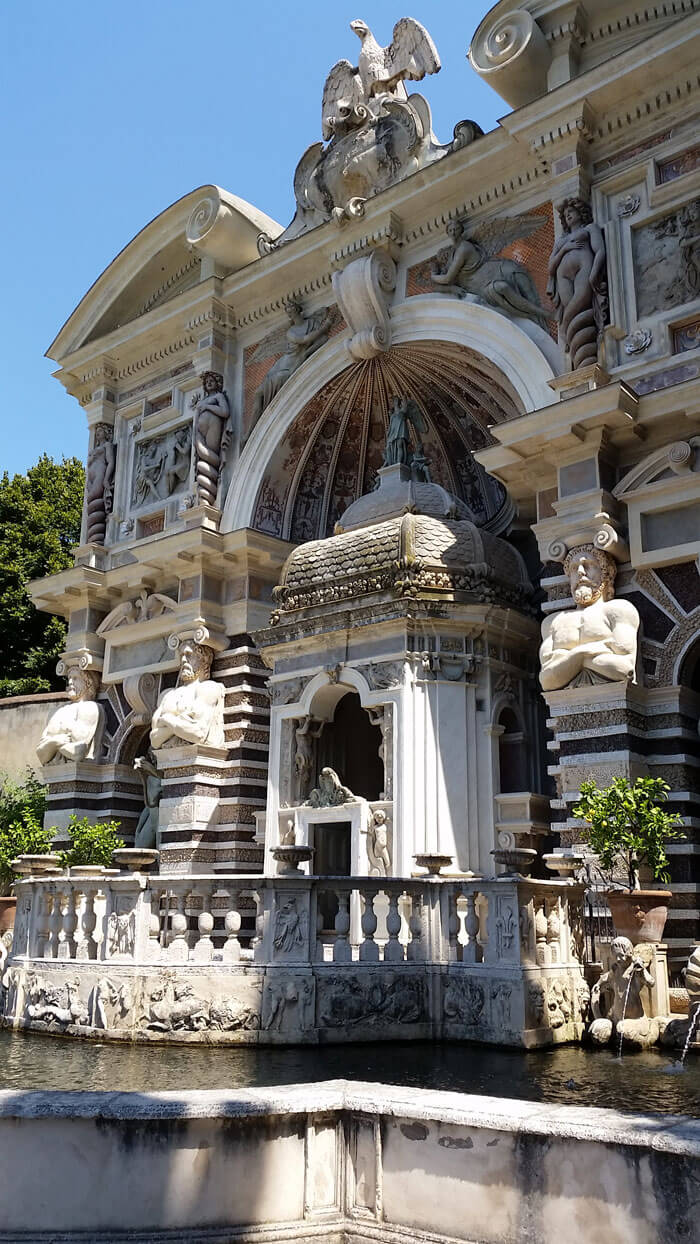
Located just outside of Rome, you’ll find some of the most stunning gardens in Italy. The official name is Villa d’Este, although everyone knows them as the Tivoli Gardens, after the town they are located in.
The 16th-century villa and Italian Renaissance gardens are a UNESCO World Heritage site and were commissioned by the Este family. Tivoli was a popular summer residence for the residents of Rome since ancient Roman times. This is due to the altitude of Tivoli offering cooler temperatures compared to the summer heat in Rome.
The Villa d’Este gardens are filled with terraced lawns, beautiful manicured flower beds and grottos surrounded with seating. It’s also famous for its fountains, which are everywhere.
In total, there are fifty-one fountains and nymphaeums which consist of 398 spouts, 364 water jets, 64 waterfalls, and 220 basins. These are fed by 875 metres of canals, channels and cascades. The most impressive aspect of this is that they all work entirely by the force of gravity, without pumps!
Some of the most iconic fountains are the row of ‘One Hundred Fountains’, the ‘Fontana dell’ Ovato’, ‘Neptune’s Fountain’ and the gigantic ‘Fountain of the Organ’, which runs down the centre of the garden.
The Fountain of the Organ gets its name from the sound it makes. The fountain was the first of its kind, with the water creating music through a series of channels, whirlpools and wind chambers which passed through the pipes to make the music!
I highly recommend the Tivoli Gardens, Villa d’Este if you’re ever in Rome, you will not be disappointed.
Villa Borghese gardens, Rome
By Merryl from Merryl’s Travel & Tricks
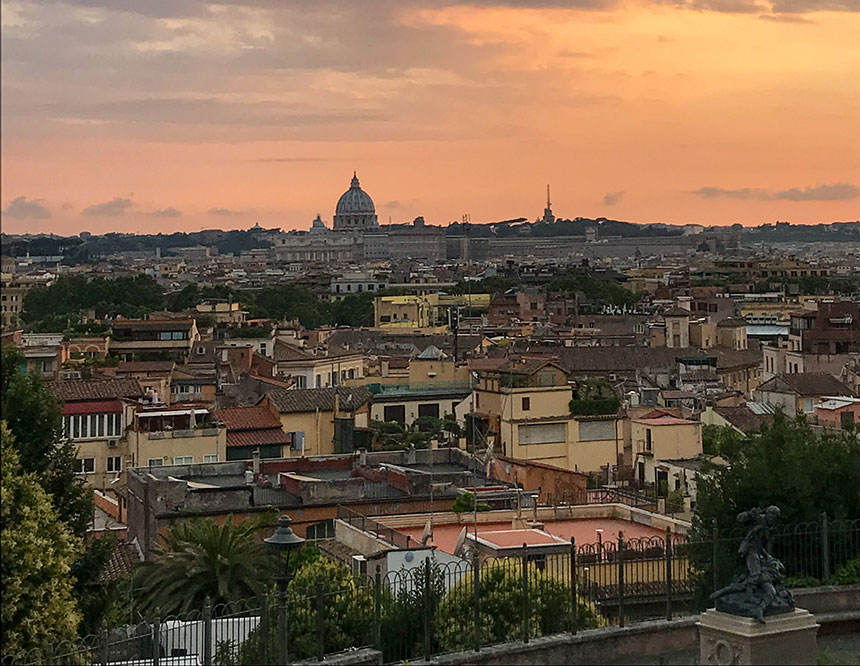
Villa Borghese is the third-largest public garden in Rome, located right in the heart of the Eternal City. The gardens were earlier owned by one of the most renowned Italian Princely families, the Borghese family from Siena.
The sprawling landscape of this beautiful garden is marked by fountains, unique Italian and English style gardens, viewpoints, sculptures and a pretty lake. Just a few minutes away from the bustling Via Del Corso and the famous Piazza Del Popolo, the Borghese Gardens offer a quiet and peaceful break from the madness of the eternal city.
Inside the Borghese gardens you will find the Borghese Gallery, the Deer Park, The Civic Museum of Zoology, Villa Medici along with various buildings of cultural relevance. Due to this, the gardens are also known as the Museum Park.
Today the park is owned by the government and is open to the public. It is frequented by locals and tourists alike. The Pincio Terrace offers beautiful sunset views of Rome, whereas the Borghese Gallery is heavenly for lovers of art and culture. During summer, the park is popular with young Romans who escape to the park for a quick Aperitivo in one of the makeshift bars or for a fun day of paddle boating on the little lake in the park.
Giardino Degli Aranci, Rome
By Annalisa from Travel Connect Experience
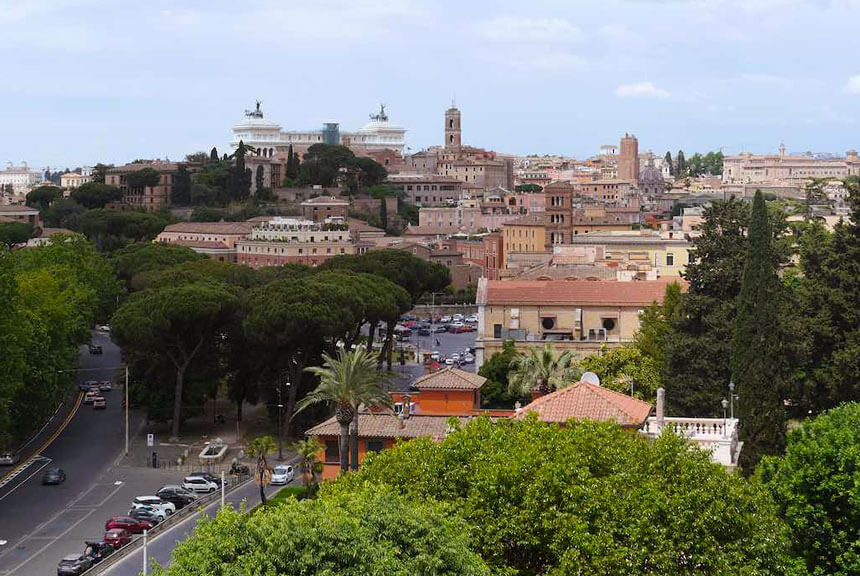
The Orange Garden, or Giardino Degli Aranci in Italian, is one of the most romantic gardens in Italy – the kind of place where you might go on a first date.
The Orange Garden is a project of architect Raffaele De Vico, who in 1932 gifted the citizens of Rome with another panoramic terrace in addition to the Pincio and the Janiculum. The strong point of the garden is a balcony with one of the best views in Rome. From there, you will admire the domes of the Pantheon and the Cathedral of St. Peter, together with the roofs of many ancient buildings immersed in the typical foliage of the umbrella pine trees.
The Orange Garden is also known as the Savelli Park in memory of the family which has owned the garden since the 13th Century. Located at the top of the Aventino Hill, one of the most elegant neighbours of Rome, the garden features numerous orange trees and pine trees. The park is crossed by a boulevard leading to the panoramic terrace. The orange tree was chosen as the symbol of this garden to remember Saint Domenico, who used to preach under an orange tree in a monastery nearby.
You can get to the garden walking for ten minutes up the Aventino Hill from the Circo Massimo Metro station. Admission to the Orange Garden is free.
Gardens in Southern Italy
Giardini La Mortella, Ischia island, Naples
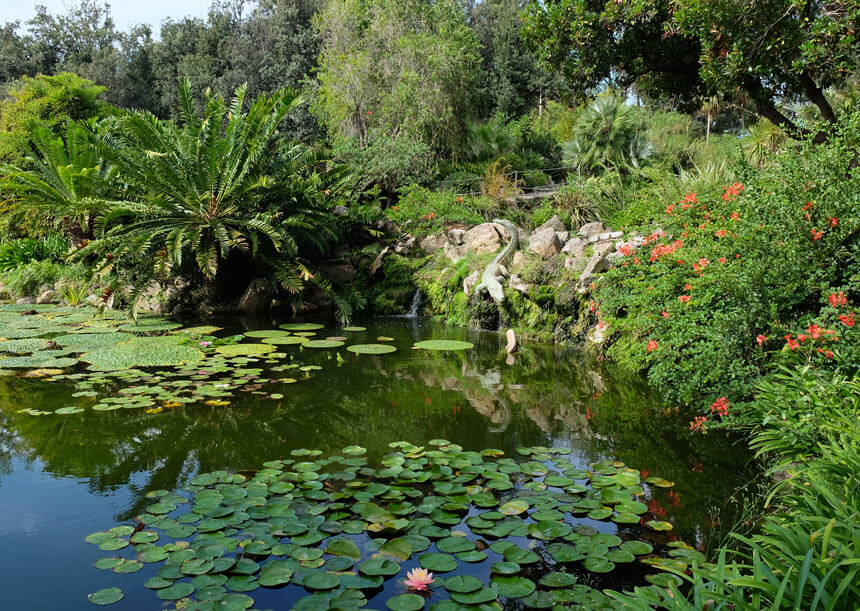
On the small island of Ischia, in the Bay of Naples, you’ll find one of the most beautiful gardens in Italy. Giardini La Mortella was created by Susana Walton, wife of the English composer Sir William Walton, after the couple moved to Ischia for its tranquil atmosphere in the 1950s.
Over several decades, Susana Walton transformed a rocky valley and the slopes above into a stunning garden, now one of the most popular things to do in Ischia. On the valley floor, the planting is lush and subtropical, with tall palms, fountains and a glasshouse holding the world’s largest species of water lily.
As you start to climb the hillside to the upper parts of Giardini La Mortella, you’ll see the memorials to both Susana and William Walton. Their ashes are buried in the garden they loved.
At the top of the garden, the planting is Mediterranean, with beautiful and unusual flowers and playful details like a very lifelike bronze crocodile.
Fittingly for a couple whose lives revolved around music, the gardens contain two concert venues. The largest is a Roman-style amphitheatre, built into the hillside with stone seats and planted with fragrant thyme.
Visiting Giardini La Mortella is an easy day trip from Naples, and can be combined with visits to other gardens on Ischia, such as the gardens at Castello Aragonese and the Negombo thermal spa and gardens.
Caserta Royal Palace and Gardens, near Naples
by Slavka from On2Continents
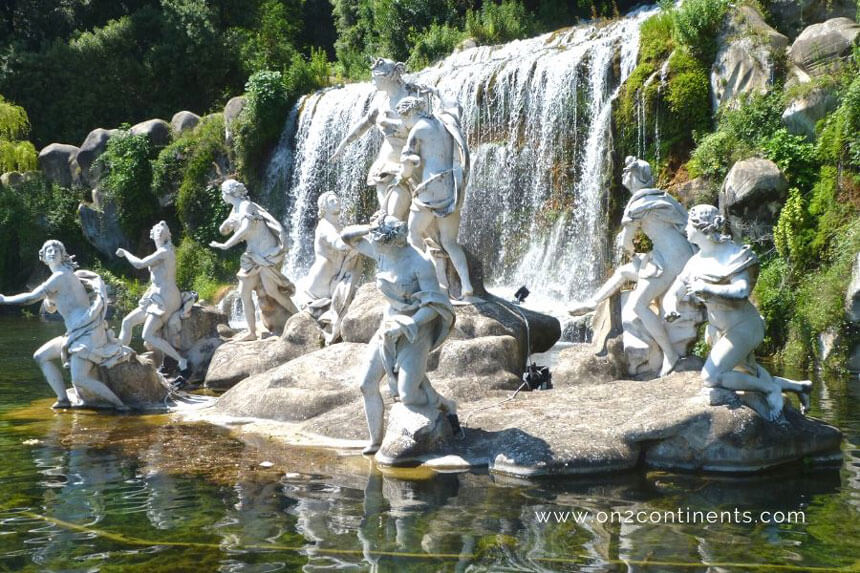
Just a short drive north from Naples you can reach the small town of Caserta. Caserta is home to a splendid Royal Place and Gardens that used to be a home of the Kingdom of Naples monarchs. The whole property was built to rival the design of French castles. Today, it is a popular tourist attraction and a great day trip destination. Countryside royal palaces always boast beautiful parkland and decorative gardens, and Caserta is no exception.
Before you tour the castle and the gardens, make sure you wear comfortable shoes and have some water and snacks with you. The palace is huge, and the gardens are immense – you’ll reach your daily walking goal here easily. First, tour the castle and then head to the gardens.
The gardens spread over 300 acres of the sloped area behind the palace and are a magnificent example of Baroque landscape architecture. They are divided into two main areas: the English Garden and the parkland-style Vantivelliano Park. The English Garden is a botanical garden that is located up on a hill. You can reach it after you walk along the many cascading fountains and tanks decorated with a myriad of Baroque statues.
The Royal Palace in Caserta is listed on the UNESCO World Heritage Sites list and in 2010, the Caserta Gardens were voted as the most beautiful gardens in the world. Without question, Caserta is well worth the visit.
Villa Cimbrone, Ravello, Amalfi Coast
By Lori from Travlinmad.com
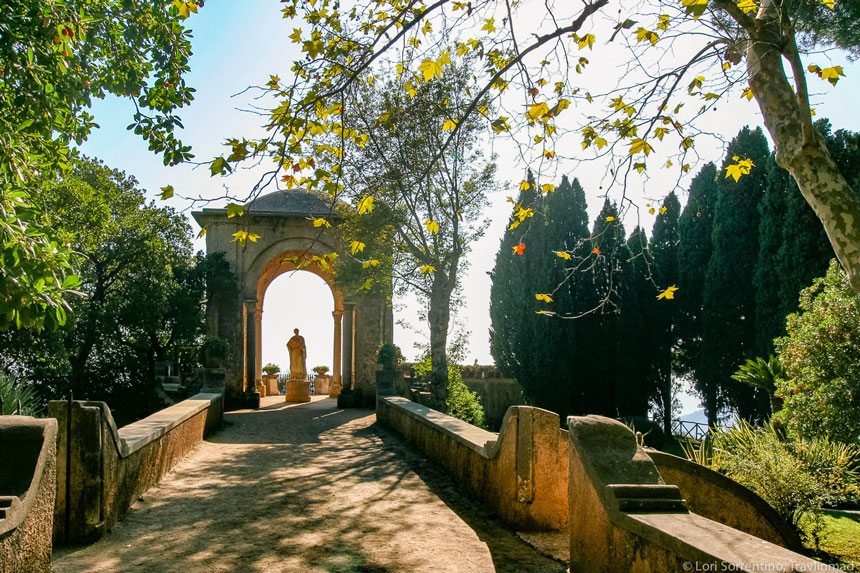
Among the many beautiful places to visit and things to do in Positano and the Amalfi Coast is a day trip to Ravello to stroll one of the most beautiful gardens in Italy at Villa Cimbrone. Located high on the cliffside over the town of Atrani, the estate was originally owned by the wealthy Acconciajoco family in the 12th century, and eventually passed through the ages to the powerful Pitti family, as in the Pitti Palace in Florence.
The name Cimbrone is derived from the lushly-covered rocky outcropping on which it was built, ‘Cimbronium’. For the past few decades, the Vuilleumer family has painstakingly restored the historic botanical garden you see today. Following guidance from historians and expert botanists and landscapers, the gardens have almost completely been restored. Walking the pathways of the manicured gardens gives the feeling of walking in the footsteps of early aristocrats.
The gardens of Villa Cimbrone surround the Terrace of Infinity with its marble-carved busts and statues, terracotta amphorae and pots, and offer one of the most breathtaking panoramas anywhere along the Amalfi Coast.
In the town centre of Ravello, you can shop for a picnic lunch with wine and enjoy the afternoon among the preserved ruins in the garden. With its wealth of plants and flowers, the gardens at Villa Cimbrone are considered one of the most prestigious and important examplexs of botany culture in the south of Europe.
Villa Communale, Trani, Puglia
By Maria & Katerina of It’s All Trip To Me
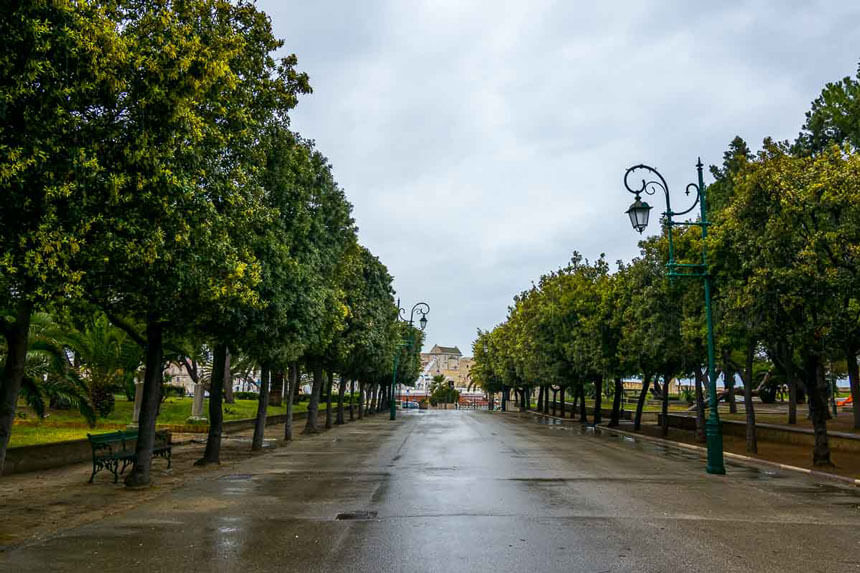
Trani is one of the most elegant coastal towns in Puglia with a charming historic centre and a gorgeous promenade. One of the best things to do in the Pearl of Puglia, as Trani is often nicknamed, is to enjoy a stroll around its public garden, the marvellous Villa Comunale.
Situated just a few steps from Trani Old Town, Villa Comunale enjoys a superb seaside location which boasts breathtaking views of the Adriatic Sea for as far as the eye can see. The garden itself is a green oasis with characteristics of both an Italian and an English garden. Tall trees, flowerbeds, sculptures and ponds compose an irresistible setting of tranquillity and relaxation.
Villa Comunale dates back to 1824 when the main part of the garden was constructed on the land the prominent Antonacci family donated to the city. Nowadays, the garden is much larger than it was back then. Villa Comunale is much loved by locals and visitors alike who seek refuge under the shade of its trees, especially on the warmest of summer days.
Probably the best time to appreciate the beauty of Trani’s public garden is sunset when views of the city’s iconic Cathedral dyed in all hues of gold and pink are simply jaw-dropping.
Gardens in Sicily
Giardini Iblei, Ragusa
By Katy from Untold Italy
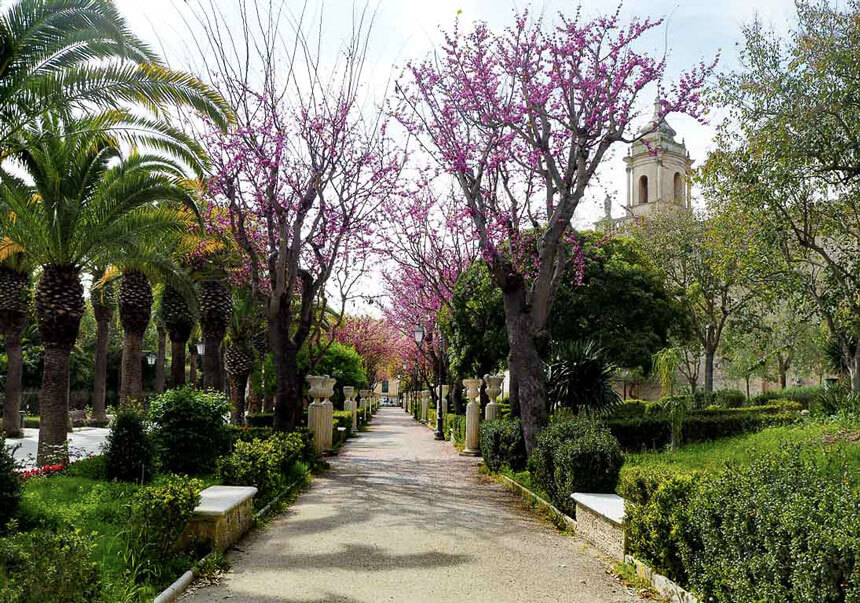
The Giardini Iblei are nestled on the edge of Ragusa Ibla, the historic old town of Ragusa in Sicily. Built in 1858, they are a peaceful oasis of palm-lined avenues and quiet nooks. The gardens were the idea of three prominent families in the town who wanted to create a place of reflection for the people of Ragusa. These days they are popular with both locals and visitors as a respite from the heat of the day and a wonderful spot for photos.
Within the Giardini Iblei, you will find local Mediterranean, and exotic species of plantlife arranged in a formal style. In springtime the gardens are awash with the deep pink, almost purple, blooms of the Judas tree (Cercis siliquastrum). The blossoms fall on the paths that connect three churches within the gardens, a memorial to fallen soldiers of the Great War and a monumental fountain in Renaissance style.
Follow the paths to the edge of the gardens and you reach a panoramic terrace overlooking the surrounding region. At 385 meters above sea level, the gardens offer stunning views of the Iblei Mountains and the Irminio River Valley. Ragusa is a UNESCO-listed town known for its stunning baroque architecture and characterful streets, but a stroll through the gardens is must-do when you visit Sicily’s Val di Noto region.
Bellini’s Garden, Catania
By Alexandrina from earthosea.com
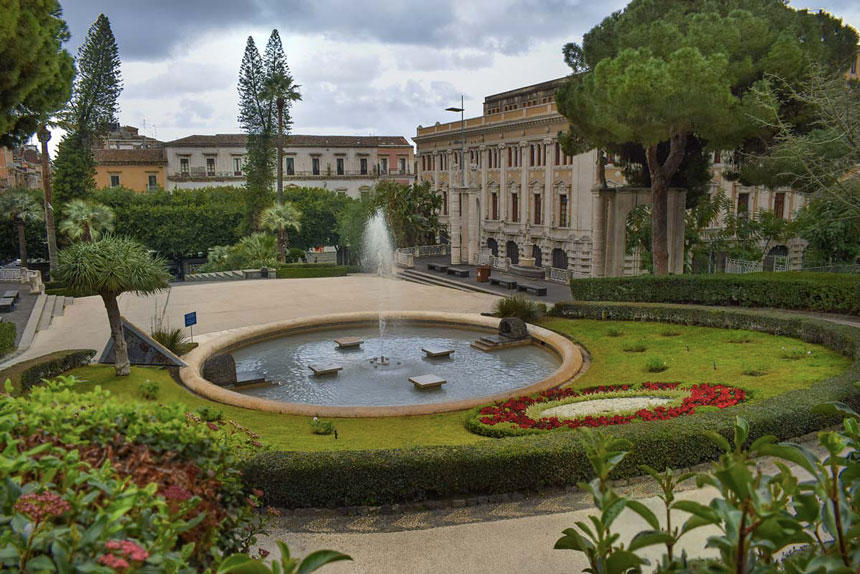
Bellini’s Garden, or as locals call it Bellini’s Villa, was named after the famous composer Vincenzo Bellini. The garden is set in the heart of the city of Catania and is simply breathtaking with its flower gardens and lush vegetation all around.
Bellini’s Garden dates back to the 18th century when it was created as a labyrinth at the will of Ignazio Paternò Castello, a prince of the Biscari family. However, later the labyrinth was bought by the municipality of Catania and was opened to the public as the city’s garden. As the story goes, there were lots of extravagant additions to the garden, such as lava stone caves, huge fountains and lots of exotic plants and animals, including peacocks, various species of apes and even an Indian elephant.
While the animals have gone, the botanical garden of Bellini still exists and has many exotic plants, such as palms from all around the world, various subtropical trees, bushes and flowers.
The garden of Bellini entrances visitors with its beautiful flower-decked fountains, mysterious tunnels and romantic bridges. Some of the most famous landmarks of Bellini’s Garden are the Illustrious Men Avenue, dedicated to the most important men of Catania and the beautiful “Concert Gazebo”.
Gardens in Sardinia
Giardini San Leonardo Siete Fuentes, Santu Lussurgiu
By Claudia from Strictly Sardinia

The gardens of San Leonardo Siete Fuentes are among the best-kept secrets of Sardinia. In an island that is mostly famous for its incredible beaches, nature is actually incredibly lush and hides lovely countryside churches and historical gardens. Visiting them is one of the best things to do in Sardinia.
The park is located a short distance from Santu Lussurgiu, and is about 90 minutes drive from Cagliari, Sardinia’s main city.
San Leonardo Siete Fuentes park measures about 5 hectares. Inside, you will find seven water springs (the “Siete Fuentes”), which can be reached via a very easy walking trail. There also is a small very scenic Medieval church that dates back to the 12th century and which used to belong to the Order of Malta. Although there are no remains, it is said that during the renaissance period there was also a hospital – probably built there because of the favourable weather conditions.
Inside the park, there also is the eerie remains of a hotel which was built in the 1950s and abandoned in 1987. If you decide to go inside (mind you, it is not the safest thing to do) you will find remains of furniture and even appliances.
The park is a lovely place to spend an afternoon away, especially for families with children.
Which of these gardens in Italy would you like to visit?
Pin it for later!
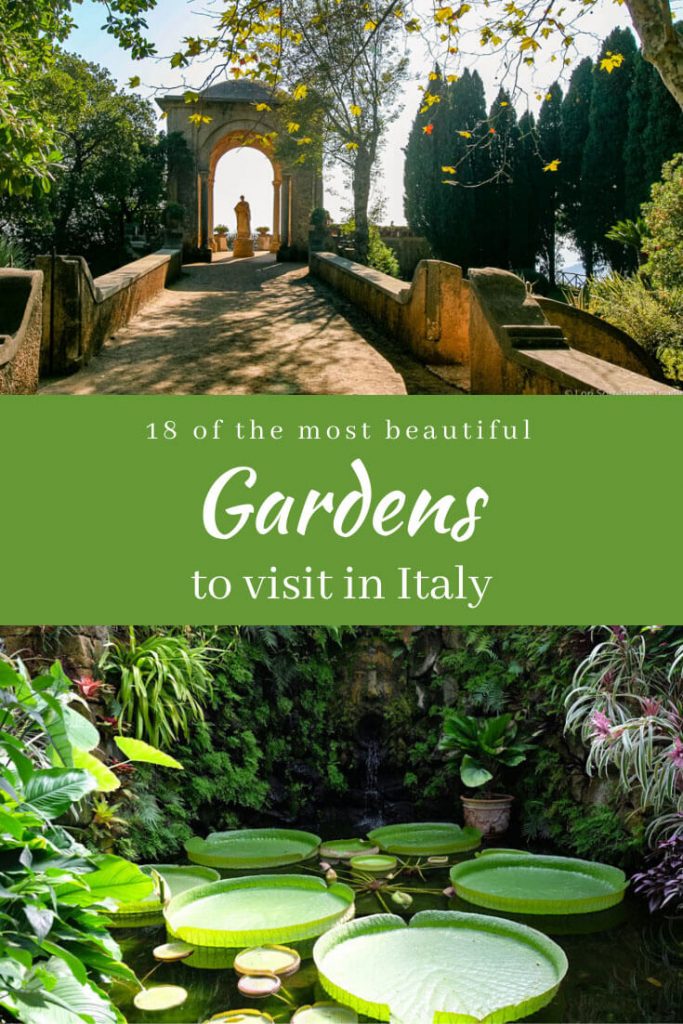


Travelling to Italy is definitely part of my bucket list but your information has elaborated it so well. Thank you